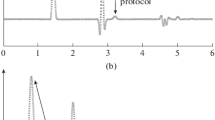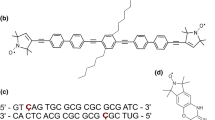Abstract
It has recently been stated that the parametrization of the time variables in the one-dimensional (1-D) mixing-frequency electron spin-echo envelope modulation (MIF-ESEEM) experiment is incorrect and hence the wrong frequencies for correlated nuclear transitions are predicted. This paper is a direct response to such a claim, its purpose being to show that the parametrization in 1- and 2-D MIF-ESEEM experiments possesses the same form as that used in other 4-pulse incrementation schemes and predicts the same correlation frequencies. We show that the parametrization represents a shearing transformation of the 2-D time-domain and relate the resulting frequency domain spectrum to the HYSCORE spectrum in terms of a skew-projection. It is emphasized that the parametrization of the time-domain variables may be chosen arbitrarily and affects neither the computation of the correct nuclear frequencies nor the resulting resolution. The usefulness or otherwise of the MIF parameters |ψ| > 1 is addressed, together with the validity of the original claims of the authors with respect to resolution enhancement in cases of purely homogeneous and inhomogeneous broadening. Numerical simulations are provided to illustrate the main points.
Similar content being viewed by others
References
Höfer P., Grupp A., Nebenführ H., Mehring M.: Chem. Phys. Lett.132, 279–283 (1986)
Schweiger A., Jeschke G.: Principles of Pulse Electron Paramagnetic Resonance. Oxford: Oxford University Press 2001.
Song R., Zhong Y.C., Noble C.J., Pilbrow J.R., Hutton D.R.: Chem. Phys. Lett.243, 324–329 (1995)
Song R., Zhong Y.C., Noble C.J., Pibrow J.R., Hutton D.R.: Chem. Phys. Lett.247, 477–483 (1995)
Song R., Zhong Y.C., Noble C.J., Pilbrow J.R., Hutton D.R.: J. Magn. Reson. A117, 320–323 (1995)
Hubrich M., Jeschke G., Schweiger A.: J. Chem. Phys.104, 2172–2184 (1996)
Gemperle C.: Thesis, ETH Zürich, No. 9192, Zurich, Switzerland, 1990.
Song R., Zhong Y.C., Noble C.J., Pilbrow J.R., Hutton D.R.: Appl. Magn. Reson.11, 391–399 (1996)
Song R.: J. Chem. Phys.105, 9046–9050 (1996)
Ponti A.: Appl. Magn. Reson.15, 1–9 (1998)
Song R.: Thesis, Monash University, Clayton, Victoria, Australia, 1996.
Tyryshkin A.M., Dikanov S.A., Goldfarb D.: J. Magn. Reson. A105, 271–283 (1993)
Höfer P.: J. Magn. Reson. A111, 77–86 (1994)
Song R., Zhong Y.C., Noble C.J., Pilbrow J.R., Hutton D.R.: Chem. Phys. Lett.237, 86–90 (1995)
Ponti A., Schweiger A.: J. Chem. Phys.102, 5207–5219 (1995)
Ernst R.R., Bodenhausen G., Wokaun A.: Principles of Nuclear Magnetic Resonance in One and Two Dimensions. Oxford: Clarendon Press 1987.
Author information
Authors and Affiliations
Rights and permissions
About this article
Cite this article
Drew, S.C., Pilbrow, J.R. On the theory of mixing-frequency electron spin-echo envelope modulation spectroscopy. Appl. Magn. Reson. 22, 561–576 (2002). https://doi.org/10.1007/BF03166133
Received:
Revised:
Issue Date:
DOI: https://doi.org/10.1007/BF03166133




